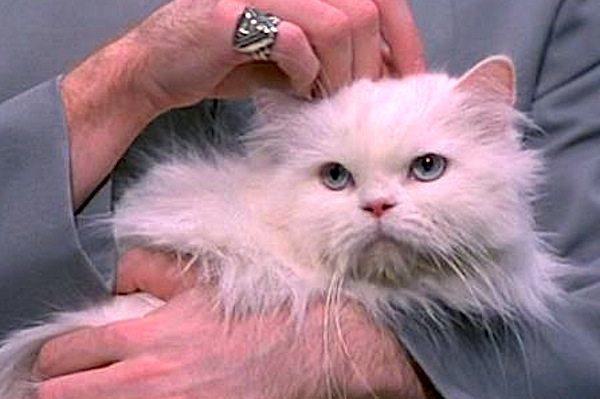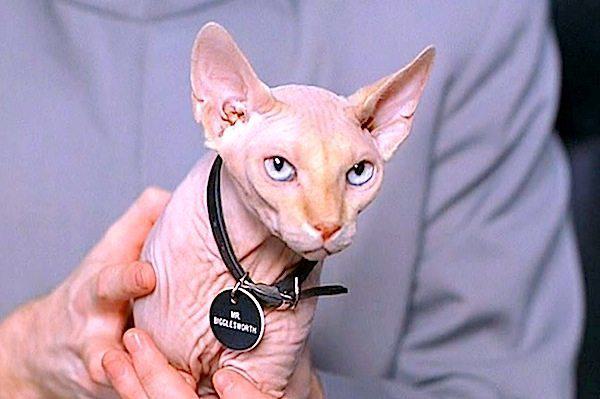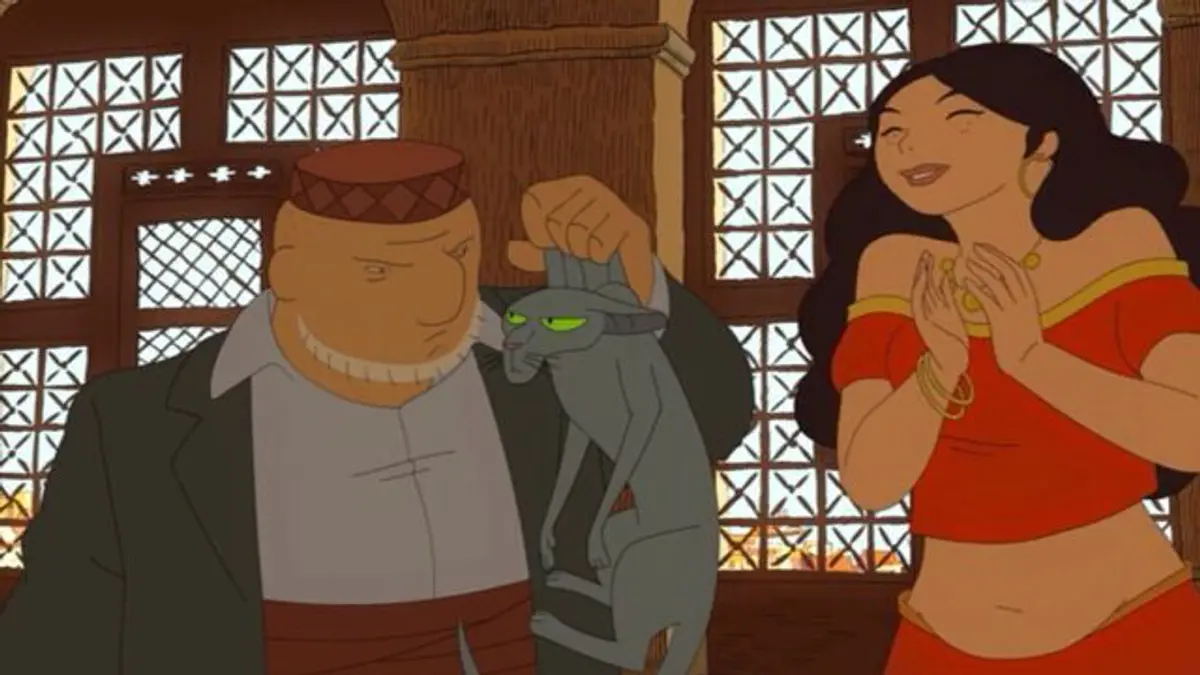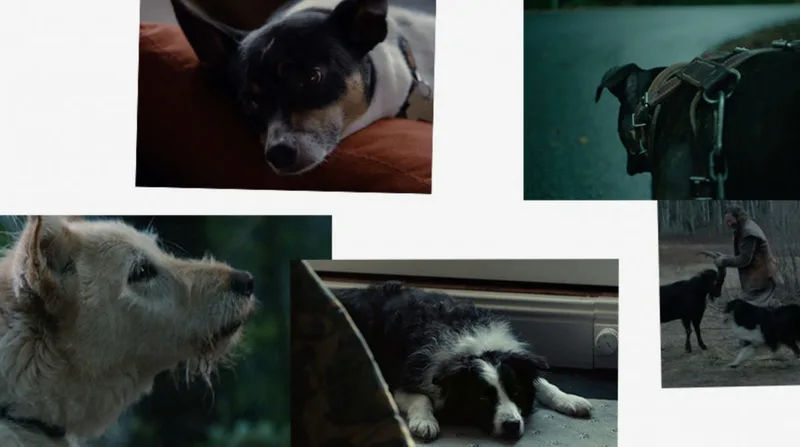By Bilge Ebiri
The cat who appears in a few scenes of the new Julianne Moore drama Gloria Bell doesn’t, at first glance, do all that much.
It doesn't even belong to the film’s eponymous character; rather it mysteriously shows up in her apartment from time to time, prompting Gloria to grumble and set it back outside, wondering which of her careless neighbors is letting their pet wander the building. But by the end, the cat has effectively adopted our lovelorn heroine; Gloria has stopped evicting the feline, instead allowing it to curl up beside her in bed, an ever-present companion.
The idea of a middle-aged single woman with a cat (or two, or five) is a cliché that goes beyond motion pictures. But there’s something notable about this cat: It’s a hairless sphynx, a far cry from the huggable fluff-balls one usually finds in movies. It’s thin, with big ears and a wedge-shaped face, the kind of cat that rarely gets cuddled with or befriended in popular culture. Indeed, hairless cats — or those without topcoats — are probably second only to black cats in the frequency with which they’re misunderstood and used to suggest peril, something unreal or eerie.
Before I proceed, some disclosure: I have a Cornish Rex that, while not technically hairless, looks very much like a space alien to people, even other cat owners. Though not much of a cuddler, she is absurdly affectionate. (She’s also, as I tweet-stormed not long ago, a big fan of Abbas Kiarostami’s 24 Frames. I’m serious.) Over the years, I’ve been perplexed, and more than a little disappointed, to see hairless and other similarly lean, big-eared cats portrayed as peculiar, dangerous, even evil.


Probably the most famous of these onscreen cats is Mr. Bigglesworth from the Austin Powers movies, who belongs to the series’ incompetent supervillain, Dr. Evil. The cat’s appearance in these films is treated as something of a joke. In the first, Austin Powers: International Man of Mystery, we see that Mr. Bigglesworth originated as a fluffy white Persian (not unlike the iconic one kept by James Bond’s arch-villain Ernst Stavro Blofeld). But then several decades spent in a cryogenic chamber rendered him hairless and “weird,” so now he’s played by a sphynx named Ted Nude-gent. And he’s a contemptuous, pissy little thing, in keeping with his bumbling, demented master.
Pretty much the same backstory accompanies the villainous title character in 2010’s Cats and Dogs: The Revenge of Kitty Galore, another Bond spoof. This one, a sequel to 2001’s Cats and Dogs, postulates a hidden universe of global espionage conducted by avuncular dogs and imperious cats. Kitty Galore is a sphynx, though we are once again assured that she didn’t start off that way: Once upon a time, she was one of the good guys, but then fell into a vat of hair-removal gel, lost all her fur, and turned evil. Gone with the topcoat, evidently, was any sense of right and wrong.
These cats don’t look the way people imagine ordinary cats to look, and thus, humans assume that something must be wrong with these creatures. They become uncanny in our eyes.
A similar dichotomy can be found in The Secret Life of Pets, which features as one of its main “good” characters an adorable tubby tabby named Chloe, and among its villains a scraggly, gruesome-looking cockney sphynx named Ozone (voiced by Steve Coogan). The latter leads a gang of alley cats who remove our heroes’ collars, thus dooming them to pursuit by Animal Control and, eventually, vagrancy. Yet again, hairless and short-haired cats are the menacing mischief-makers, duplicitous and uncaring.
I’m tempted to say that this tradition of creepy, cruel, slender cats dates back to Disney’s Lady and the Tramp, with its singing (and somewhat racist), havoc-wreaking Siamese duo Si and Am, who destroy their owner’s house and then pin the crime on our innocent canine heroine Lady, who gets muzzled in return. But in truth, the tradition probably goes a lot further. These cats don’t look the way people imagine ordinary cats to look, and thus, humans assume that something must be wrong with these creatures. They become uncanny in our eyes.

There are some rare exceptions to this type of depiction, however. In the 2011 French animated film, The Rabbi’s Cat, the title character is a sphynx devoted to his mistress, the vivacious young daughter of a rabbi in French-occupied Algiers. The cat, who gains the power of speech after eating the family parrot, accompanies the Rabbi on a series of surreal adventures that take them across Africa. (It’s a strange, sometimes wonderful movie.) Though he remains nameless, this cat is the unequivocal hero, a full-blooded, sympathetic character – curious, argumentative, and also loyal.
Because cats are hard to train, most of the examples I've cited have been from animated films, either hand-drawn or CGI. And given the way animals are anthropomorphized onscreen, they often come from children’s fare. Films for grown-ups don’t do much better, alas.
In 1960’s Portrait in Black, Lana Turner and Anthony Quinn conspire to murder her husband, who owns a loyal Siamese cat named Rajah. This cat, who lounges on his bed and later shows up as a kind of silent witness to the duo’s misdeeds, even gets to participate in a classic cat jump scare. And while Rajah certainly seems loyal, the film plays up the creature’s strangeness, continuing the streak of suspicious Siamese cats in mid-20th century movies. (Lady and the Tramp is from 1955. A pair of odd Siamese very briefly show up in 1944’s tale of international intrigue, The Mask of Dimitrios, as well.)
A silent Cornish Rex appears in a more recent lurid tale of adultery and murder in 2016’s Lady Macbeth, about an English woman in a wealthy but loveless marriage who has an affair with a laborer and then kills both her father-in-law and husband. Yet again, the cat occasionally seems to bear witness to the heroine’s crimes, though this one is less judgmental. Nevertheless, the presence of an unusual-looking cat serves, as always, to enhance the unease of the proceedings.
Finally, I have no idea if we can call David Lynch’s Dune (1984) a film for grown-ups, but few who’ve seen it will forget the villainous Baron Harkonnen’s cat-milking contraption. It involves a hairless cat and a rat strapped to a bizarre little device, which the Baron uses to torture his victims: The prisoners have to try and drink the cat’s milk as an antidote to the poison the Baron has administered to them. Because, well, David Lynch.
The reasons why these depictions can be so frustrating is that, in reality, hairless cats tend to be more affectionate, not less. Since they lack the thick fur to protect them from colder temperatures, they are constantly seeking warmth and companionship — a lap to rest on, a leg to rub against, or a shoulder to perch on (they do that, yes). That’s why the development of Gloria’s relationship with her sphynx in Gloria Bell ultimately feels so satisfying, like a necessary corrective: The human goes from apprehension to acceptance and affection, while the cat itself always seems to be there looking for, and offering, friendship.




